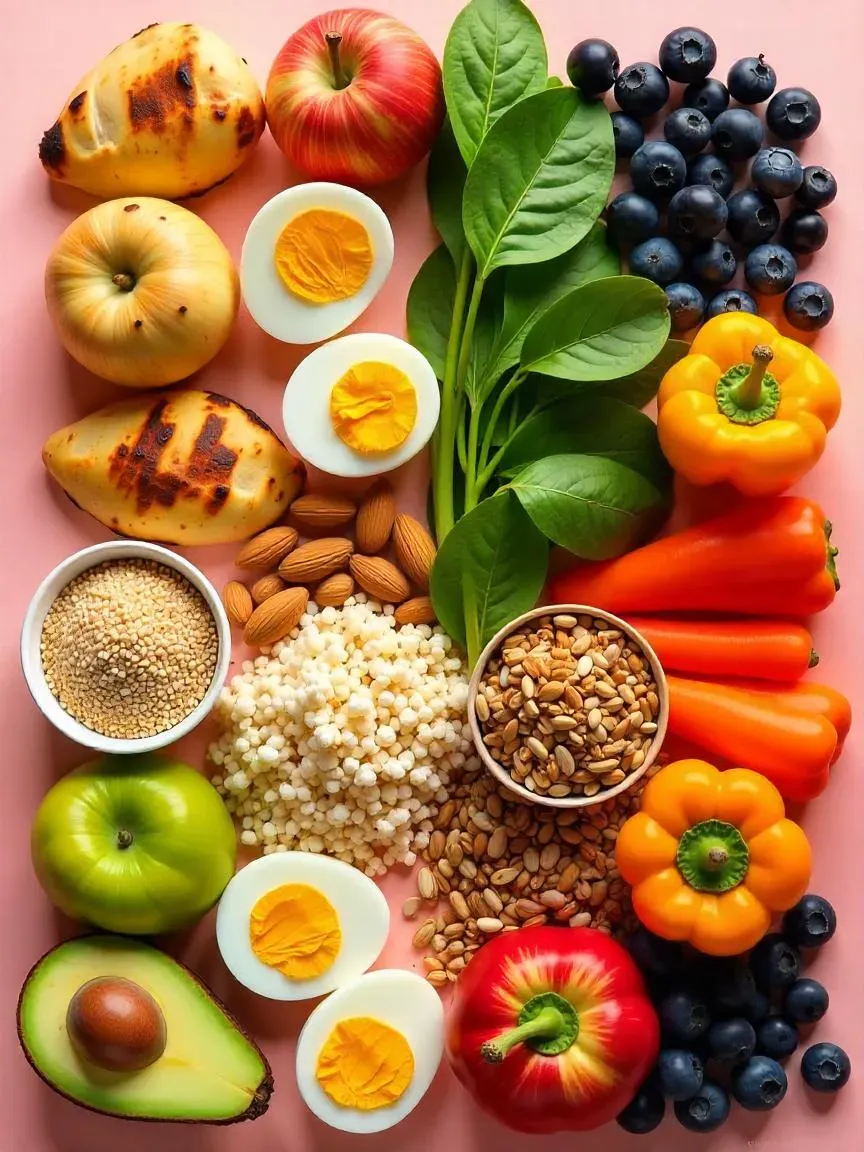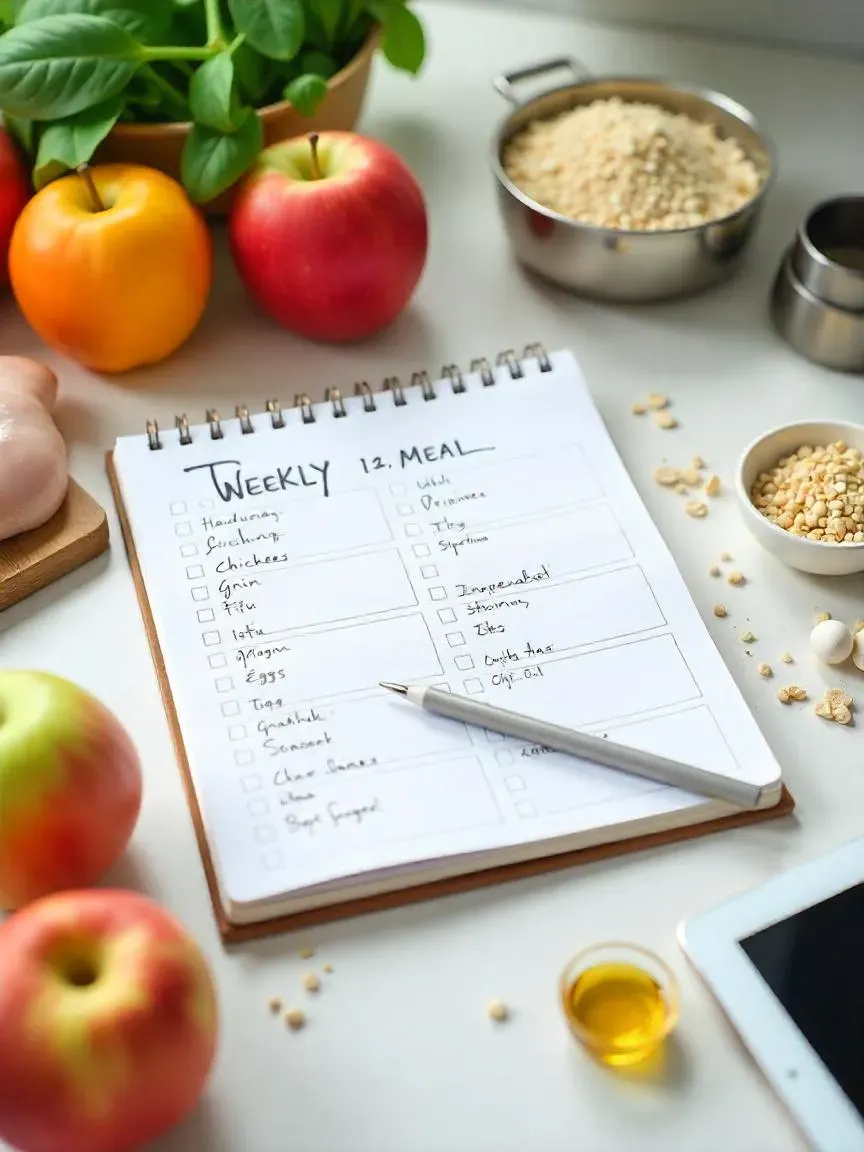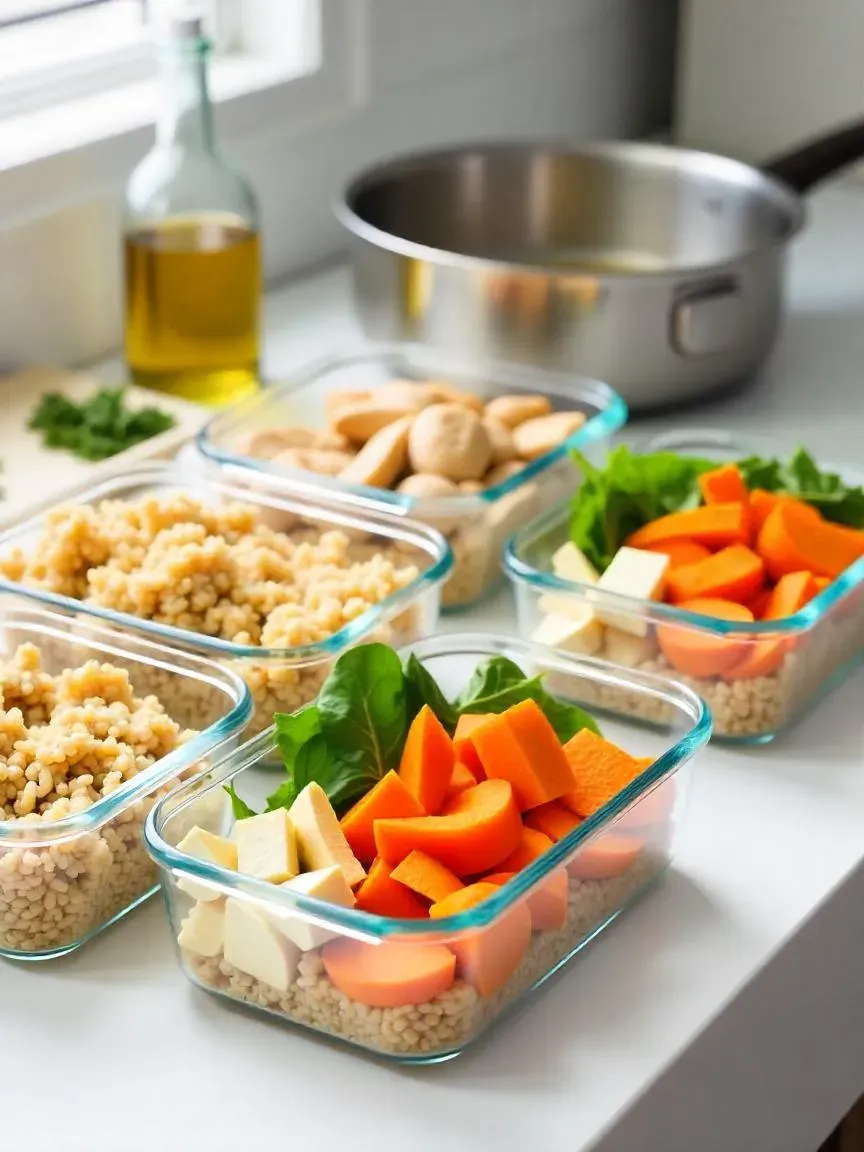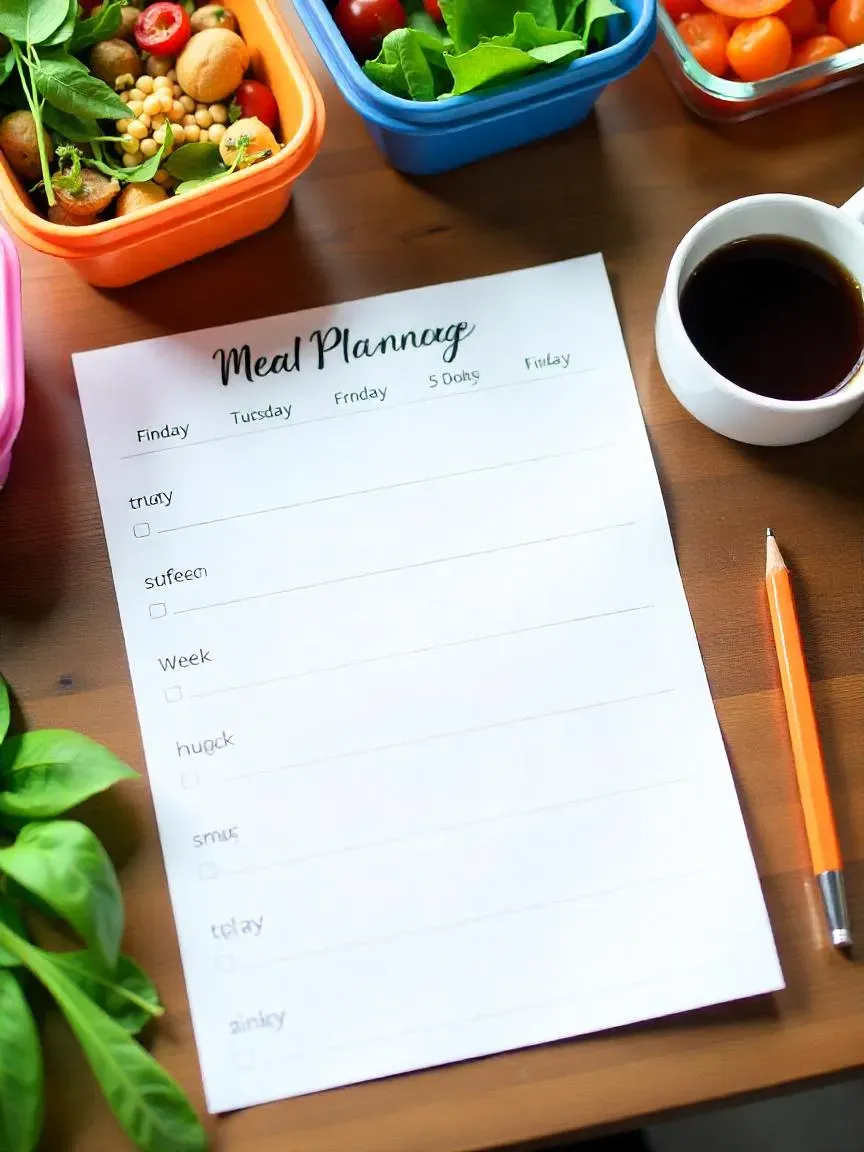Contents
- 🥗 Understanding Nutrition Basics: The Foundation of Healthy Meal Planning
- 🥦 Micronutrients and Their Importance in Meal Planning
- 📝 Planning Your Meals: Where Nutrition Meets Organization
- 🧩 Balancing Variety and Consistency: The Key to Sustainable Meal Planning
- ⏳ Considering Time and Budget Constraints
- 🛒 Shopping Smart: The Secret Ingredient to Meal Planning Success
- 🌿 Seasonal Shopping Strategies: Maximize Freshness, Flavor & Savings
- 🍳 Preparation and Cooking Tips: Simplify Meal Prep & Maximize Nutrition
Planning your weekly meals isn’t just about organizing your grocery list — it’s a powerful tool for transforming your health, saving time, and bringing joy back into your kitchen. With a well-structured meal plan, you can eliminate the daily stress of deciding what to eat, reduce food waste, and ensure every meal you prepare supports your nutritional goals.
✅ Save time and energy:
By mapping out your meals in advance, you avoid last-minute takeout orders or unhealthy food choices, making each day smoother and more efficient.
✅ Make healthier decisions effortlessly:
When your meals are thoughtfully planned, it’s easier to include a balanced variety of vegetables, lean proteins, healthy fats, and whole grains.
✅ Control portions and reduce food waste:
Shopping with a plan means buying exactly what you need, minimizing excess and ensuring fresher, more vibrant ingredients.
✅ Rediscover the joy of cooking:
When you’re not rushed or stressed, cooking becomes a creative and enjoyable process that fuels both your body and your mind.
With just a little preparation each week, you can create a simple system that supports your wellness journey, satisfies your taste buds, and keeps your schedule on track. In this article, we’ll explore easy, actionable tips to help you plan nutritious weekly menus that are both practical and delicious — no complicated meal prep or rigid diets required!
🥗 Understanding Nutrition Basics: The Foundation of Healthy Meal Planning

Before building a successful weekly meal plan, it’s essential to understand the basics of nutrition. Knowing how different nutrients fuel your body allows you to create well-rounded meals that support your energy, immunity, and long-term wellness goals.
🔬 Macronutrients: The Building Blocks of Your Diet
Every meal you eat contains macronutrients — the major nutrients your body needs in larger amounts to function properly. A balanced combination of these is crucial for optimal health:
🍞 Carbohydrates — The Body’s Primary Energy Source
Carbs provide the quick and sustained energy your body and brain need to stay sharp and active throughout the day. They are found in:
- Fruits (apples, bananas, berries)
- Vegetables (sweet potatoes, corn, squash)
- Whole grains (brown rice, quinoa, oats)
- Legumes (beans, lentils, peas)
✅ Tip: Focus on complex carbohydrates with fiber for steady energy and better digestion.
🍗 Proteins — Essential for Repair and Growth
Protein is necessary for building and repairing tissues, supporting muscle health, hormone production, and immune function. Excellent protein sources include:
- Lean meats (chicken, turkey, beef)
- Fish and seafood
- Eggs and dairy products (yogurt, cottage cheese)
- Plant-based proteins (tofu, tempeh, legumes, quinoa, nuts, and seeds)
✅ Tip: Include a protein source in every meal to stay full longer and support metabolism.
🥑 Fats — Vital for Hormonal Balance and Nutrient Absorption
Healthy fats help absorb fat-soluble vitamins (A, D, E, and K), regulate hormones, and provide long-lasting energy. Key healthy fat sources include:
- Olive oil and avocado oil
- Avocados
- Fatty fish (salmon, mackerel, sardines)
- Nuts and seeds (almonds, chia seeds, flaxseeds)
✅ Tip: Choose unsaturated fats while limiting trans fats and highly processed oils.
🧬 Why Balance Matters
Balancing macronutrients ensures you:
- Maintain steady blood sugar
- Support muscle repair and growth
- Improve brain function and mood
- Boost overall energy and stamina
When you build your meal plan around this foundation, you’re not just eating — you’re nourishing your body intentionally for both short-term wellness and long-term health.
🥦 Micronutrients and Their Importance in Meal Planning
While macronutrients fuel your body, micronutrients — vitamins and minerals — act as the behind-the-scenes heroes that keep your systems running smoothly. Even though you need them in smaller amounts, they are absolutely vital for your overall health.
🧪 Vitamins: Tiny Nutrients with Big Roles
Vitamins regulate countless processes in your body, from metabolism to immune defense and even mood balance. Each vitamin serves specific roles:
- Vitamin C: Supports immunity, wound healing, and collagen production (found in citrus fruits, bell peppers, strawberries).
- B Vitamins (B1, B2, B3, B6, B12, Folate): Aid in energy metabolism, brain function, and red blood cell production (found in whole grains, dairy, leafy greens, lean meats).
- Vitamin D: Supports bone health and immune function (found in fortified foods, fatty fish, or from sunlight).
- Vitamin A: Supports vision, skin health, and immune defense (found in carrots, sweet potatoes, spinach).
🧲 Minerals: The Body’s Chemical Messengers
Minerals regulate nerve function, bone strength, and fluid balance. Key minerals include:
- Calcium: Vital for bone and teeth health, muscle contractions, and nerve signaling (found in dairy, leafy greens, fortified plant milks).
- Iron: Essential for oxygen transport in the blood (found in red meat, legumes, spinach).
- Potassium: Supports proper muscle function and blood pressure control (found in bananas, potatoes, avocados).
- Magnesium: Involved in muscle relaxation, energy production, and stress regulation (found in nuts, seeds, leafy greens).
👉 Key tip: A colorful plate often means a nutrient-dense plate — incorporate a variety of fruits, vegetables, whole grains, and proteins for optimal micronutrient intake.
📝 Planning Your Meals: Where Nutrition Meets Organization

Now that you understand what your body needs, let’s translate that into an effective meal planning strategy.
🎯 Setting Your Dietary Goals
Before you begin planning, define your personal health objectives:
- Weight management: Calorie-controlled portions with balanced macronutrients.
- Muscle gain: Higher protein intake combined with strength training.
- General wellness: Focus on variety, micronutrient intake, and whole foods.
Key considerations:
- Calculate your daily caloric needs based on age, sex, activity level, and goals.
- Ensure proper balance between macronutrients (carbs, proteins, fats) and micronutrients (vitamins, minerals).
- Create a list of favorite, go-to ingredients that align with your goals for easier planning.
📊 Tracking and Adjusting
- Use meal planning apps or simple journals to track your meals and progress.
- Monitor energy levels, satiety, and physical results.
- Adjust your meal plan as your body’s needs change over time.
By understanding both macronutrient and micronutrient needs — and pairing that with clear dietary goals — you can craft a highly personalized weekly menu that fuels your body and simplifies your life.
🧩 Balancing Variety and Consistency: The Key to Sustainable Meal Planning
One of the biggest secrets to successful weekly meal planning is finding the perfect balance between variety and consistency. This approach keeps meals interesting, ensures nutritional diversity, and helps you stay motivated week after week.
🥗 Why Variety Matters
Incorporating a wide range of foods helps you:
- Prevent boredom: Avoid eating the same meals repeatedly.
- Cover more nutrients: Different foods offer different vitamins, minerals, and antioxidants.
- Discover new favorites: Trying new recipes may introduce ingredients you’ll love.
✅ Tips to Add Variety:
- Rotate recipes: Pick a set of 5–7 recipes each week and rotate them monthly to keep things fresh.
- Use seasonal produce: Seasonal fruits and vegetables are not only fresher and tastier but often more affordable.
- Experiment with world cuisines: Introduce simple dishes from various cultures — Mediterranean, Asian, or Latin-inspired meals can bring exciting new flavors to your table.
🧱 Why Consistency Is Also Important
While variety keeps things interesting, consistency simplifies the planning process. A flexible routine allows you to:
- Spend less time making decisions.
- Stick to your nutritional goals.
- Build grocery lists more easily.
✅ Simple Consistency Formula:
- Protein: Chicken, tofu, fish, beans, or eggs.
- Vegetable: Leafy greens, broccoli, bell peppers, or seasonal options.
- Whole grain or starch: Brown rice, quinoa, sweet potatoes, or whole-grain pasta.
Using this basic template, you can easily swap ingredients while maintaining balanced meals.
⏳ Considering Time and Budget Constraints
Meal planning shouldn’t feel overwhelming. With a few smart strategies, you can fit healthy eating into any busy schedule and budget.
💡 Time-Saving Strategies:
- Batch cooking: Prepare double portions and store leftovers for quick lunches or future dinners.
- Prep ahead: Chop vegetables, marinate proteins, or pre-cook grains on weekends.
- One-pan or sheet-pan meals: Simplify cleanup while cooking complete, balanced meals.
💰 Budget-Friendly Tips:
- Shop with a list: Stick to your meal plan and avoid unnecessary purchases.
- Buy in bulk: Stock up on pantry staples like beans, rice, oats, and frozen vegetables.
- Use store brands: Often just as nutritious but more affordable.
- Limit food waste: Plan to use perishable items early in the week to ensure nothing goes unused.
🎯 Pro Tip:
Use free online meal planning templates, grocery apps, or printable shopping lists to stay organized, efficient, and stress-free.
🛒 Shopping Smart: The Secret Ingredient to Meal Planning Success

Smart grocery shopping is the cornerstone of effective weekly meal planning. With a little preparation, you can save time, stay on budget, and ensure that your kitchen is stocked with everything you need for a week of balanced, nutritious meals.
📝 Making a Grocery List: Your Meal Planning Roadmap
A detailed grocery list is one of the most powerful tools for meal prep success. It keeps you focused, reduces food waste, and helps avoid unnecessary purchases.
✅ Steps for creating an efficient grocery list:
1️⃣ Review your meal plan:
Look at your weekly menu and write down all required ingredients for each meal.
2️⃣ Check your kitchen inventory:
Take stock of what you already have in your pantry, fridge, and freezer to avoid duplicates.
3️⃣ Organize by category:
Group items into sections like:
- Produce
- Proteins
- Dairy
- Grains
- Frozen
- Spices/Condiments
This makes shopping faster and more organized, helping you navigate the store or online grocery app with ease.
4️⃣ Stick to the list:
A well-planned list keeps you focused, reducing impulse buys that can derail your budget or nutritional goals.
🥗 Choosing Fresh Over Processed: Prioritize Whole, Nutritious Foods
While convenience foods may seem tempting, fresh and minimally processed ingredients are always the better choice for health and taste.
✅ Why fresh is better:
- Higher nutrient content: Fresh produce retains more vitamins and minerals.
- Fewer additives and preservatives: Whole foods are free from excess sodium, sugars, and artificial ingredients.
- Better flavor and texture: Fresh fruits, vegetables, and proteins taste better and make meals more satisfying.
✅ Smart fresh food choices:
- 🍎 Fresh fruits (apples, berries, citrus)
- 🥬 Leafy greens (spinach, kale, romaine)
- 🐟 Lean proteins (chicken breast, salmon, tofu)
- 🌾 Whole grains (brown rice, quinoa, oats)
- 🥕 Seasonal vegetables (broccoli, carrots, asparagus)
Pro Tip: Shopping local farmers’ markets or choosing in-season produce often results in better prices and fresher food.
🎯 Bonus Hack:
Always shop after eating! Shopping while hungry often leads to extra, unnecessary items ending up in your cart.
🌿 Seasonal Shopping Strategies: Maximize Freshness, Flavor & Savings

Incorporating seasonal produce into your weekly meal plan isn’t just good for your wallet — it also delivers peak flavor, optimal nutrition, and supports local farmers. Shopping with the seasons allows you to enjoy foods when they’re at their freshest and most nutrient-dense.
🌱 Why Shop Seasonally?
✅ Better Flavor:
Produce harvested at its natural peak tastes sweeter, juicier, and more vibrant.
✅ Higher Nutritional Value:
Fruits and vegetables lose nutrients over time; eating them close to harvest ensures you get the most vitamins, minerals, and antioxidants.
✅ Lower Cost:
Abundant seasonal produce is often cheaper due to local availability and lower transportation costs.
✅ Support Local Agriculture:
Buying from farmers’ markets helps small farms and reduces your carbon footprint.
📅 Sample Seasonal Produce Guide
| Season | Fruits | Vegetables |
|---|---|---|
| Spring | Strawberries, apricots | Asparagus, spinach, peas |
| Summer | Berries, peaches, melons | Zucchini, corn, tomatoes |
| Fall | Apples, pears, pomegranates | Pumpkins, Brussels sprouts, squash |
| Winter | Citrus fruits, kiwi | Kale, cabbage, root vegetables |
(Note: Always check your local seasonal chart as availability can vary by region.)
🛒 How to Shop Seasonally
- Do your research:
Look up local seasonal produce guides or apps specific to your area. - Visit farmers’ markets:
Connect directly with local growers for the freshest picks. - Plan your meals around the season:
Let seasonal produce inspire your weekly menu — you’ll enjoy more variety while naturally rotating nutrients. - Be flexible:
Swap ingredients in your recipes based on what’s fresh and abundant that week.
🎯 Pro Tip:
Seasonal shopping makes meal planning more exciting and prevents boredom. It’s an easy way to introduce variety into your meals while staying budget-friendly and nutrient-rich.
🍳 Preparation and Cooking Tips: Simplify Meal Prep & Maximize Nutrition

Planning your meals is only half the battle — how you prepare and cook your food plays a huge role in maintaining both nutritional value and long-term success. With a few simple strategies, you can save time, reduce stress, and keep your meals both delicious and healthy.
🥣 Batch Cooking & Meal Prepping: The Time-Saving Secret
Batch cooking allows you to prepare multiple meals at once, cutting down your weekday cooking time to mere minutes.
✅ Benefits of batch cooking:
- Save time during busy weekdays.
- Reduce daily decision fatigue.
- Limit temptation for unhealthy takeout or snacking.
- Maintain portion control effortlessly.
✅ How to start batch cooking:
1️⃣ Select versatile recipes:
Choose meals that can be easily mixed and matched throughout the week (grain bowls, stir-fries, salads, soups).
2️⃣ Cook in bulk:
Prepare large batches of proteins (chicken, tofu, beans), grains (brown rice, quinoa), and roasted vegetables.
3️⃣ Store properly:
Use airtight glass containers or BPA-free plastic containers.
💡 Label with the date to ensure freshness and easy grab-and-go access.
4️⃣ Schedule prep days:
Dedicate 1–2 hours over the weekend for prepping — you’ll thank yourself all week long!
🍽 Healthy Cooking Techniques for Flavorful, Nutritious Meals

How you cook your food is just as important as what you eat. Opt for cooking methods that preserve nutrients while minimizing added fats and sugars.
✅ Top healthy cooking methods:
- Steaming:
Perfect for vegetables and seafood — retains vitamins and keeps flavors clean and vibrant. - Grilling or broiling:
Adds smoky flavor without the need for excess oils or heavy sauces. Excellent for lean meats, vegetables, and fish. - Sautéing with minimal oil:
Use non-stick pans or substitute with water, broth, or olive oil spray to reduce fat intake. - Baking or roasting:
Ideal for sheet-pan meals; locks in natural moisture while concentrating flavors. - Slow cooking or pressure cooking:
Saves time while breaking down tougher proteins and fibers, preserving nutrients with less heat exposure.
✅ Flavor boosters without extra calories:
- Fresh herbs and spices (basil, cilantro, turmeric, paprika)
- Citrus zest and juice (lemon, lime, orange)
- Garlic, onions, and ginger
🎯 Pro Tip:
Healthy cooking doesn’t have to be complicated — focus on simple techniques that highlight the natural flavors of fresh, whole ingredients.





“Totally! Planning my meals is a game-changer. It’s not just about the list, it’s about actually *enjoying* cooking again. No more staring blankly into the fridge at 6pm! Plus, I’m eating so much healthier and saving a fortune on takeout – definitely worth the little bit of time it takes on Sunday.”